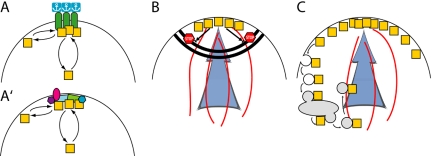Figure 1.
Mechanisms underlying polarized protein distribution. A protein of interest (squares) displaying an asymmetric distribution at the cell cortex can attain that polarization via one or more of the indicated mechanisms. (A) A preexisting asymmetric distribution of an anchored interacting factor can concentrate the protein of interest. Here, the interacting factor is shown connected to an extracellular anchor that might be a site of cell-cell contact, or an immobilizing extracellular matrix, or the yeast cell wall. A variant of the anchor model (A′) is that a dynamic patch of interacting proteins is assembled by a symmetry-breaking process and serves to localize the protein of interest. Like the anchor model, this does not require input from the cytoskeleton. However, the anchor-like patch is not fixed but dynamic, and can assemble de novo at random locations. (B) A diffusion barrier (stop signs indicate blocked movement of the squares), such as the claudin-dependent tight junction, or the yeast septin-dependent neck cortex, can keep a cortical protein from crossing the fence (thick double black line). For this to produce a polarized distribution, the protein must be delivered to only one side of the fence (indicated by the blue arrow), along polarized cytoskeletal elements (red lines). (C) Polarized delivery (blue arrow and red lines as in B) can yield a polarized distribution in the absence of a diffusion barrier if active recycling of the protein (here indicated by endocytic internalization, passage through a recycling endosome, and reexport along the polarized cytoskeleton) is fast enough to counter diffusion.

